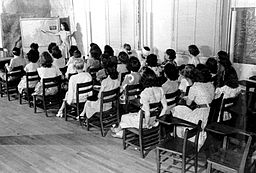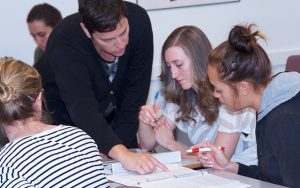Ever wondered what ACC’s administrators at HBC do all day? Well, like you, we swirl and spin and move from running a meeting to responding to a student complaint to dealing with a personnel issue to gathering information for an update to signing what needs to be signed to checking email to offering advice to writing reports to making decisions – and then we start all over again. Yesterday was one of those swirling and spinning days for me, and I couldn’t get The Beatles’ “A Day in the Life” out of my head. “Woke up, fell out bed, dragged a comb across my head.” So – with apologies to The Beatles – I thought I would offer a little insight into a typical day in the life of an AVP. A bullet list seems most appropriate, so here you go. I’ve included the occasional annotation where a little more explanation is required.
A Day In My Life As AVP of Academic Programs:
- Checked email, answered some, put some aside. Rinse, repeat throughout the day.
- Started to make my “to do” list for the day. But then . . .
- Received a call to go down to Mike’s office where I was given a task and a two-hour time frame.

What task, you ask?
We’re still trying to make sure we have accurate information about faculty move requests, office assignments for requested moves and new faculty, and confirmation that moves have occurred or are scheduled. There’s a massive master spreadsheet that needed to be triple-checked before Mike went into a “campus moves” meeting in two hours.
Some lines on the spreadsheet said “new full-time faculty” and needed a name and a campus location. Other lines had a campus request but no assigned office. Other lines were duplicates that needed to be deleted. Some showed a move as pending that had been completed. You get the idea.
Across academic programs we have a lot of moves – more than usual with the closing of Pinnacle and the opening of San Gabriel – and quite a few new full-time faculty who need offices. So confirming information meant texting one dean who was at a conference, texting another dean who was on his way to a conference, calling a third dean in his office, and trying to catch the Executive Director of Adult Ed before she left for a meeting. Luckily everyone returned my calls or answered my texts!
Now, back to my bullet list.
- Had hallway meeting (at the copy machine) with Marvi Reyes in PICM about how to recruit FTICs (first-time-in-college students) for our Fall Institutes using data provided by Matt Figg on “projected new students” and “FTICs with fewer than 6 semester credit hours”.
- Acted on an email with an off-cycle pay request that needed to be signed and pdf’d to Payroll. It was the same song, second verse (and third, and fourth verses) throughout the day – every time I returned to checking email there was a new off-cycle pay request in the bunch.
- Addressed a process question about First Day Access.
What question, you ask?
How do you handle FDA when a faculty member who chooses to use that option for her students withdraws from teaching a section and the new faculty member doesn’t want to use that FDA book?
Figuring out a process for this (because students will need to be refunded their FDA fees) required working with Dianne Olla, Cheryl Coe (Student Accounts), and the department chair, among others. Do we delete the FDA fees on the section (triggering a refund to registered students), or do we cancel the section and create a new one that the registered students will need to sign up for? How do we alert the three students registered in the section to the changes? Who alerts them? What is the timeline on refunds to the students? Who makes sure the course schedule note is removed? Who notifies the bookstore?
FDA is new, so all our processes associated with it are new. And we’re still creating those processes. As you can see.
Now, back to my bullet list (again).
- Met with Grant Potts and Estrella Barrera who are co-chairing our Faculty Advising (now called Mentoring) Implementation Work Group.
- Worked on a draft of updates to the full-time faculty job posting template.
- Prepped for a meeting first thing the next morning. Prepping means developing the agenda, putting the handouts together, and thinking through the implications of the issues we were trying to address.
- Took delivery of Institute standing banners for our Institute campuses. Each banner comes in its own (unmarked) bag, so each had to be opened to determine which campus is to get which bag. So yes, I opened each one, pulled out the banner to see which Institute it was, and labeled the carrying bag.
- Delivered the Business Studies Institute banner to Northridge Student Services.
I revisited my “to do” list at the end of the day to confirm that I had not made any progress on anything on the list. In fact, I had not had any time to look at the “to do” list since the work day began. But I had gotten some things accomplished nonetheless.
And I listened to the The Beatles on the drive home. (“Now they know how many holes it takes to fill the Albert Hall. . .”)
Picture credit: By Adam Diaz [CC BY-SA 4.0 (https://creativecommons.org/licenses/by-sa/4.0)], from Wikimedia Commons


 But students change, and technology improves, and the art and craft and science of teaching and learning shifts. This little article in
But students change, and technology improves, and the art and craft and science of teaching and learning shifts. This little article in 
 Next, someone on Twitter flipped the question:
Next, someone on Twitter flipped the question: You know how folks are always offering advice? In a recent edition of The Chronicle of Higher Education, the advice from David D. Perlmutter includes “listen as well as you speak”.
You know how folks are always offering advice? In a recent edition of The Chronicle of Higher Education, the advice from David D. Perlmutter includes “listen as well as you speak”.